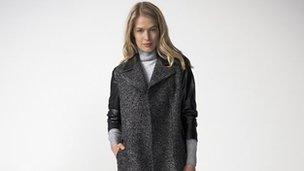How big retailers learned the tricks of high fashion
- Published
Fashions now take 90 days to reach Woolworths' shelves, according to chief executive Ian Moir
When Sir Stuart Rose says something on retail, it's worth listening. With a 40-year track record in the industry, the former chief executive and chairman of Marks and Spencer is famed for turning around struggling retailers.
Now an independent, non-executive director at South Africa's Woolworths Holdings, a chain of shops selling fashion, food, beauty and home ware, he says retail has changed.
"Where the customer used to be king before, the customer is now the master of the universe: and they want what they want, how they want it, when they want it."
For Woolworths, this shift has been felt most keenly in clothing - an area that along with beauty and home ware makes up 38% of its business in South Africa.
In response, over the past two to three years it has made a conscious effort to make its clothing more fashionable, which crucially has involved getting it from the design stage to the shop floor much more quickly.
"Previously it was 11-months-plus for all of our clothing products to the point now where we can turn [an item] around in 90 days," says Ian Moir, chief executive of Woolworths (which has no connection with the former British High Street chain of the same name).
The strategy appears to be working. The company's most recent results for the year to the end of June, external saw clothing sales grow by 13.7%.
"If we don't give the customer the trend, the colour, the fashion they're looking for, at the end of the day they're going to go somewhere else," says Mr Moir.
New shopping ethos
Neil Saunders, managing director at retail consultancy Conlumino, says the changes at Woolworths reflect a "sea change" in how supermarket groups sell clothing.
"They have become more like clothing retailers. Five years ago they used to merchandise it in the same way as, for example, baked beans. They piled it high and sold it cheap. But now they have become lifestyle rather than commodity-led."
Mr Saunders says the 2008 financial crisis and resulting recession is a key reason behind this change in approach, with a trend for people to choose quality items that they expect to last.
"Before the recession people bought lots of stuff... they even bought stuff they didn't wear. There was a disposable element because clothing was cheap and people felt affluent.
"People are more frugal now. They buy less stuff and follow the ethos of, 'If you buy it right you buy it once.'"
Mr Saunders says, however, that low prices can still lure in customers if they are combined with fashion, citing Primark as an example. "It's on trend and that makes people very interested. But if a retailer just chases value then they struggle," he adds.
Fashion focus
UK supermarket group Sainsbury's founded its clothing range Tu almost a decade ago.
James Brown, clothing business director at Sainsbury's, says when Tu began it was focused on core products such as leggings, jogging bottoms and T-shirts, with ranges changed every 12 weeks or longer. But in the past two years it has become more trend-led.
"Since our recent rebrand the new Tu range is refreshed every six weeks to keep up with the latest fashions, and offer new products to our customer," says Mr Brown.

Sainsbury's has increased its focus on fashion since it founded its clothing range Tu
"Over the last nine years we have learnt more about our broad customer base and have adapted the range to offer more High Street-style garments at supermarket prices to meet customer demand," he adds.
The approach seems to be working - at its recent trading update for the 16 weeks to 28 September, external it said its general merchandise and clothing business grew at more than twice the rate of its food business.
Mr Brown says new items are planned up to seven months in advance, but that it can react quickly to last-minute trends by turning around a style in just eight weeks, assuming it can get the necessary fabric and has the production capacity.
Turnaround time
In contrast, for High Street chain Zara, production capacity is rarely an issue because unusually its owner Inditex has its own factories.
These manufacture what it says is a "significant share" of its clothing for its eight brands, which include upmarket Massimo Dutti and teen label Bershka, but primarily the most fashionable garments.
.jpg)
Hot fashion items at Zara can be designed and on the shelves in just two weeks
For those items the clothes can be produced and in store in a rapid two to three weeks.
"Customer expectations are higher than ever so our capability to adapt and react to their demands is one of our key strengths," says an Inditex source.
For Ian Moir, this is the key to Woolworths' future.
"The importance of fashion is becoming greater and greater and customer awareness is getting better and better.
"They're very fashion aware and they want it now. That's the way the world is going, it's the way it's changing and it's the way we've got to change as a business."
Escape from the Boardroom is a five-part series broadcast on BBC World News on Saturdays at 02:10 and 15:10, and Sundays at 09:10 and 21:10 (all times GMT).
- Published11 October 2013
- Published4 October 2013
- Published27 September 2013
- Published20 September 2013